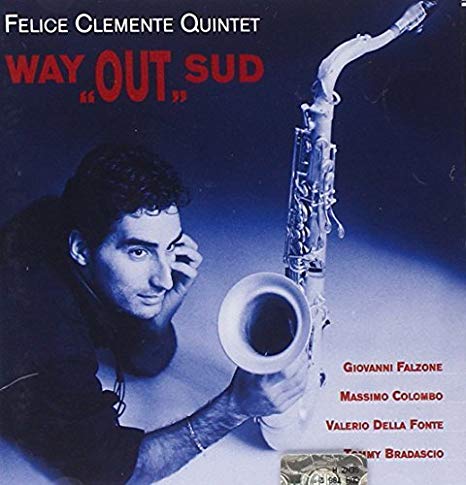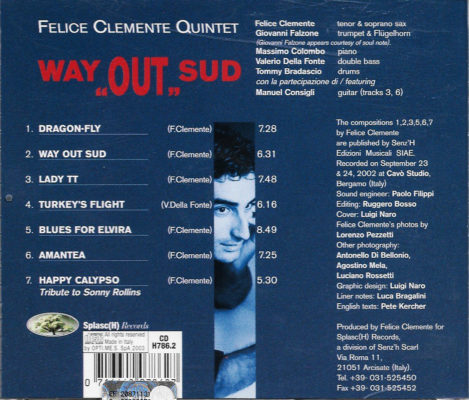2003


FELICE CLEMENTE | Tenor and soprano sax
GIOVANNI FALZONE | Trumpet and flugelhorn
MASSIMO COLOMBO | Piano
VALERIO DELLA FONTE | Double-bass
TOMMY BRADASCIO | Drums
The quintet was founded in 1998 by Felice Clemente and is made up of prominent musicians of the contemporary jazz scene. A meeting point between artists who have found in music their reason for living, enhanced by the convergence of a plurality of languages in relation to their diverse training (classical music, jazz, Afro-Cuban, etc. …). The quintet is connected by a deeply rooted culture that animates and justifies its music production, thanks to clear references to the mainstream and hard-bop, yet a very modern take.
The project WAY OUT SUD, strongly advocated by the Milanese saxophonist, represents the meeting point between the jazz and Afro-Cuban traditions, intertwined through a profound research and an inspired compositional vein, then finally manifested in the recording of the album “Way Out Sud”, named after the quintet produced by the record label.
SPLASC(H) RECORDS.
Review by Luca Bragalini
A touch of smug irony turns the compass of Sonny Rollins’ famous masterpiece, Way Out West, to another cardinal point, this time heading South. However, the title is not at all referred to the South of the United States, the cradle of blues and jazz between the Mississippi and the New Orleans brothels, as depicted in the imaginary of many. This music takes you to the South of our own land, particularly to the region of Calabria. This is where Felice Clemente’s roots are, and that very memory, blurred by the passing of time and yet vivid with nostalgia, nourishes the composition of Way Out Sud, as well as of the sophisticated Amantea.
A work that shows the overflowing boldness and recklessness of some amongst the most inspired debut works, yet without disregarding the past, which is that of the artist’s own life journey, of course, but also the past of the history of jazz.
Therefore, WAY OUT SUD can be defined as a traditional record. A term that could sometimes shock, as it uncomfortably touches our sensitivity, so deeply engrained in the romantic belief that only the new and the original is worth of interest, as we perceive the adjective “traditional” as a shameful epithet.
And yet, if you consider the history of jazz (the real one, trimmed of lies, legends and stories) you will soon realise that all the greatest geniuses of this music were able to take their giant leap into the future, precisely because they were well rooted in the past, because their ideas were based on a tradition that was never rejected. The music of Louis Armstrong, Thelonious Monk or Ornette Coleman is both revolutionary and traditional (and this is where their magic resides).
The compositions of WAY OUT SUD (all of them are original work by Clemente, except for Turkey’s Flight, by bassist Valerio Della Fonte) pay their tribute to the giants of the 50’s hard-bop: the intuitions, the timbres, the formal solutions of Horace Silver, Sonny Rollins, Dexter Gordon, Thelonious Monk appear from time to time, as you listen to this album. Yet, this precious heritage does not materialize in a music that is a conglomerate of clichés, but quite the contrary, it turns to be the stimulus liberating the creativity of each one of the musicians of the quintet. Just listen to Blues for Elvira. The homage to Monk’s blues is palpable and manifest: the chromatic incipit à la Blue Monk, the fragments of rapid hexagonal scales, the harmonies in tension chords, the unsettling rhythmic shifts (even Monk’s favourite B flat tone)… And yet, what we listen to is absolutely unique. Clemente and his musicians did nothing but mull over Monk and the traditional blues (have a listen to their inspired piano and trumpet solos) throughout the song, in a deeply personal way, just as Monk himself pondered on Gershwin’s Nice Work If You Can Get It throughout his life, with such distinctiveness that the song, after all, became Monk’s work. The opening track of the album, Dragon Fly, is also an excellent piece of work. The formal structure is reminiscent of Silver (and his blues in Soulville minor keys) yet again Clemente’s writing stands out. Surprising, with his unexpected pauses set in the phraseology of the theme; and then, Clemente’s elegant tenor improvisation and the poignant solo of Falzone’s trumpet that begins with a thirteenth tension chord.
Way Out Sud also brings back to mind the great legacy of Afro-Cuban music in jazz (a leitmotif that the great Jelly Roll Morton had already identified, in his Crescent City, so exquisitely Spanish, at the beginning of the 20th century). The title track is in fact based on an oscillating rhythm between songo and swing, while Happy Calypso takes you the Virgin Islands dances, filtered through Rollins’ St. Thomas. It is in this song that drummer Tommaso Bradascio carves out a space for a unique improvisation chorus with a unique melodic sense.
And then, what a subtle melancholy is introduced by Manuel Consigli’s guitar in Lady TT… a composition that alternates a section B built on a rich harmonic movement with a part A in the bright key of F major, where the music seems to stop, suspended in the air, thanks to a reiterated tonic pedal. A track that is filled with lightness and grace, and then comes the beautiful soprano solo by Clemente.
Finally, how could I not highlight the subtle (and therefore even more dominant) tribute to the artist’s homeland and personal journey: Amantea. A lulling rhythm in 6/8 connects two single harmonies, as they become even more crucial thanks to a single tonic pedal. A wide, open space, as infinite as the Tyrrhenian Sea, as you gaze upon it from the coast… and the graceful soprano melody counterpointed by the flugelhorn rising above it all. Together, they remind you the warmth of the sun. Because, after all, sooner or later we all turn back, not so much to yearn for the past, but to look back home, just like Satchmo to his New Orleans.
Luca Bragalini